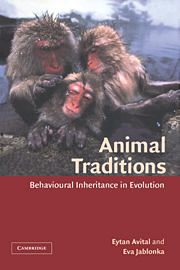Book contents
- Frontmatter
- Contents
- Preface
- Acknowledgements
- 1 New rules for old games
- 2 What is pulling the strings of behaviour?
- 3 Learning and the behavioural inheritance system
- 4 Parental care – the highroad to family traditions
- 5 Achieving harmony between mates — the learning route
- 6 Parents and offspring – too much conflict?
- 7 Alloparental care – an additional channel of information transfer
- 8 The origins and persistence of group legacies
- 9 Darwin meets Lamarck – the co-evolution of genes and learning
- 10 The free phenotype
- References
- Index of species
- Index of subjects
5 - Achieving harmony between mates — the learning route
Published online by Cambridge University Press: 28 October 2009
- Frontmatter
- Contents
- Preface
- Acknowledgements
- 1 New rules for old games
- 2 What is pulling the strings of behaviour?
- 3 Learning and the behavioural inheritance system
- 4 Parental care – the highroad to family traditions
- 5 Achieving harmony between mates — the learning route
- 6 Parents and offspring – too much conflict?
- 7 Alloparental care – an additional channel of information transfer
- 8 The origins and persistence of group legacies
- 9 Darwin meets Lamarck – the co-evolution of genes and learning
- 10 The free phenotype
- References
- Index of species
- Index of subjects
Summary
The mother-mouse portrayed in the previous chapter worked hard to rear her offspring, providing them with all the essentials: with food and warmth, with information and with security. As a typical mammalian single mother, she was not assisted in her labours, and hence did not enjoy the increased reproductive success that the help of another individual, such as her mate, might bring. But in some species of mammals and most birds, the mother is not the only caregiver; frequently the father participates in parental care and contributes to the offspring's ‘education’. Paternal involvement is not without complications, however, and sometimes there are conflicts between the parents over who should care for the youngsters, how much care should be given and for how long. Mates may also disagree over copulation frequency, fidelity and the level of commitment to the relationship. Indeed, our everyday experience of the relationships between human mates, as well as observations of monogamous birds and mammals, testify to frequent disagreements. The great Scandinavian playwright August Strindberg, one of the most bitter and eloquent writers on the struggle between the sexes, described the conflict between human males and females as being as old as sex itself and fundamentally insoluble. But what does this ancient conflict mean for biologists? Can we interpret family disputes as a reflection of conflicting evolutionary interests? How is the regular and often spectacular co-operation between mates achieved?
- Type
- Chapter
- Information
- Animal TraditionsBehavioural Inheritance in Evolution, pp. 141 - 170Publisher: Cambridge University PressPrint publication year: 2000



